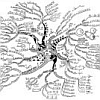| |
|
| |
 
Jialiang Yang,
Stefan Grünewald and
Xiu-Feng Wan. Quartet-Net: A Quartet Based Method to Reconstruct Phylogenetic Networks. In MBE, Vol. 30(5):1206-1217, 2013.
Keywords: from quartets, phylogenetic network, phylogeny, Program QuartetNet, reconstruction.
Toggle abstract
"Phylogenetic networks can model reticulate evolutionary events such as hybridization, recombination, and horizontal gene transfer. However, reconstructing such networks is not trivial. Popular character-based methods are computationally inefficient, whereas distance-based methods cannot guarantee reconstruction accuracy because pairwise genetic distances only reflect partial information about a reticulate phylogeny. To balance accuracy and computational efficiency, here we introduce a quartet-based method to construct a phylogenetic network from a multiple sequence alignment. Unlike distances that only reflect the relationship between a pair of taxa, quartets contain information on the relationships among four taxa; these quartets provide adequate capacity to infer a more accurate phylogenetic network. In applications to simulated and biological data sets, we demonstrate that this novel method is robust and effective in reconstructing reticulate evolutionary events and it has the potential to infer more accurate phylogenetic distances than other conventional phylogenetic network construction methods such as Neighbor-Joining, Neighbor-Net, and Split Decomposition. This method can be used in constructing phylogenetic networks from simple evolutionary events involving a few reticulate events to complex evolutionary histories involving a large number of reticulate events. A software called Quartet-Net is implemented and available at http://sysbio.cvm.msstate.edu/QuartetNet/. © 2013 The Author."
|
|
| |
   
Thi-Hau Nguyen,
Vincent Ranwez,
Vincent Berry and
Celine Scornavacca. Support Measures to Estimate the Reliability of Evolutionary Events Predicted by Reconciliation Methods. In PLoS ONE, Vol. 8(10):e73667, 2013.
Keywords: duplication, from rooted trees, from species tree, phylogenetic network, phylogeny, polynomial, Program GraphDTL, reconstruction.
Note: http://dx.doi.org/10.1371/journal.pone.0073667.
Toggle abstract
"The genome content of extant species is derived from that of ancestral genomes, distorted by evolutionary events such as gene duplications, transfers and losses. Reconciliation methods aim at recovering such events and at localizing them in the species history, by comparing gene family trees to species trees. These methods play an important role in studying genome evolution as well as in inferring orthology relationships. A major issue with reconciliation methods is that the reliability of predicted evolutionary events may be questioned for various reasons: Firstly, there may be multiple equally optimal reconciliations for a given species tree-gene tree pair. Secondly, reconciliation methods can be misled by inaccurate gene or species trees. Thirdly, predicted events may fluctuate with method parameters such as the cost or rate of elementary events. For all of these reasons, confidence values for predicted evolutionary events are sorely needed. It was recently suggested that the frequency of each event in the set of all optimal reconciliations could be used as a support measure. We put this proposition to the test here and also consider a variant where the support measure is obtained by additionally accounting for suboptimal reconciliations. Experiments on simulated data show the relevance of event supports computed by both methods, while resorting to suboptimal sampling was shown to be more effective. Unfortunately, we also show that, unlike the majority-rule consensus tree for phylogenies, there is no guarantee that a single reconciliation can contain all events having above 50% support. In this paper, we detail how to rely on the reconciliation graph to efficiently identify the median reconciliation. Such median reconciliation can be found in polynomial time within the potentially exponential set of most parsimonious reconciliations. © 2013 Nguyen et al."
|
|
| |
  
Chris Whidden,
Robert G. Beiko and
Norbert Zeh. Fixed-Parameter Algorithms for Maximum Agreement Forests. In SICOMP, Vol. 42(4):1431-1466, 2013.
Keywords: agreement forest, explicit network, FPT, from rooted trees, hybridization, minimum number, phylogenetic network, phylogeny, Program HybridInterleave, reconstruction, SPR distance.
Note: http://arxiv.org/abs/1108.2664, slides.
Toggle abstract
"We present new and improved fixed-parameter algorithms for computing maximum agreement forests of pairs of rooted binary phylogenetic trees. The size of such a forest for two trees corresponds to their subtree prune-and-regraft distance and, if the agreement forest is acyclic, to their hybridization number. These distance measures are essential tools for understanding reticulate evolution. Our algorithm for computing maximum acyclic agreement forests is the first depth-bounded search algorithm for this problem. Our algorithms substantially outperform the best previous algorithms for these problems. © 2013 Society for Industrial and Applied Mathematics."
|
|
| |
|
| |
  
Yun Yu,
R. Matthew Barnett and
Luay Nakhleh. Parsimonious Inference of Hybridization in the Presence of Incomplete Lineage Sorting. In Systematic Biology, Vol. 62(5):738-751, 2013.
Keywords: from network, from rooted trees, hybridization, lineage sorting, parsimony, phylogenetic network, phylogeny, Program PhyloNet, reconstruction.
Toggle abstract
"Hybridization plays an important evolutionary role in several groups of organisms. A phylogenetic approach to detect hybridization entails sequencing multiple loci across the genomes of a group of species of interest, reconstructing their gene trees, and taking their differences as indicators of hybridization. However, methods that follow this approach mostly ignore population effects, such as incomplete lineage sorting (ILS). Given that hybridization occurs between closely related organisms, ILS may very well be at play and, hence, must be accounted for in the analysis framework. To address this issue, we present a parsimony criterion for reconciling gene trees within the branches of a phylogenetic network, and a local search heuristic for inferring phylogenetic networks from collections of gene-tree topologies under this criterion. This framework enables phylogenetic analyses while accounting for both hybridization and ILS. Further, we propose two techniques for incorporating information about uncertainty in gene-tree estimates. Our simulation studies demonstrate the good performance of our framework in terms of identifying the location of hybridization events, as well as estimating the proportions of genes that underwent hybridization. Also, our framework shows good performance in terms of efficiency on handling large data sets in our experiments. Further, in analysing a yeast data set, we demonstrate issues that arise when analysing real data sets. Although a probabilistic approach was recently introduced for this problem, and although parsimonious reconciliations have accuracy issues under certain settings, our parsimony framework provides a much more computationally efficient technique for this type of analysis. Our framework now allows for genome-wide scans for hybridization, while also accounting for ILS. [Phylogenetic networks; hybridization; incomplete lineage sorting; coalescent; multi-labeled trees.] © 2013 The Author(s). All rights reserved."
|
|
| |
   
Gergely J. Szöllösi,
Eric Tannier,
Nicolas Lartillot and
Vincent Daubin. Lateral Gene Transfer from the Dead. In Systematic Biology, Vol. 62(3):386-397, 2013.
Keywords: duplication, lateral gene transfer, likelihood, loss, phylogeny, Program TERA, reconstruction.
Note: http://dx.doi.org/10.1093/sysbio/syt003.
Toggle abstract
"In phylogenetic studies, the evolution of molecular sequences is assumed to have taken place along the phylogeny traced by the ancestors of extant species. In the presence of lateral gene transfer, however, this may not be the case, because the species lineage from which a gene was transferred may have gone extinct or not have been sampled. Because it is not feasible to specify or reconstruct the complete phylogeny of all species, we must describe the evolution of genes outside the represented phylogeny by modeling the speciation dynamics that gave rise to the complete phylogeny. We demonstrate that if the number of sampled species is small compared with the total number of existing species, the overwhelming majority of gene transfers involve speciation to and evolution along extinct or unsampled lineages. We show that the evolution of genes along extinct or unsampled lineages can to good approximation be treated as those of independently evolving lineages described by a few global parameters. Using this result, we derive an algorithm to calculate the probability of a gene tree and recover the maximum-likelihood reconciliation given the phylogeny of the sampled species. Examining 473 near-universal gene families from 36 cyanobacteria, we find that nearly a third of transfer events (28%) appear to have topological signatures of evolution along extinct species, but only approximately 6% of transfers trace their ancestry to before the common ancestor of the sampled cyanobacteria. © 2013 The Author(s)."
|
|
| |
    
Gergely J. Szöllösi,
Wojciech Rosikiewicz,
Bastien Boussau,
Eric Tannier and
Vincent Daubin. Efficient Exploration of the Space of Reconciled Gene Trees. In Systematic Biology, Vol. 62(6):901-912, 2013.
Keywords: duplication, explicit network, lateral gene transfer, likelihood, loss, phylogeny, Program ALE, reconstruction.
Note: http://arxiv.org/abs/1306.2167.
Toggle abstract
"Gene trees record the combination of gene-level events, such as duplication, transfer and loss (DTL), and species-level events, such as speciation and extinction. Gene tree-species tree reconciliation methods model these processes by drawing gene trees into the species tree using a series of gene and species-level events. The reconstruction of gene trees based on sequence alone almost always involves choosing between statistically equivalent or weakly distinguishable relationships that could be much better resolved based on a putative species tree. To exploit this potential for accurate reconstruction of gene trees, the space of reconciled gene trees must be explored according to a joint model of sequence evolution and gene tree-species tree reconciliation. Here we present amalgamated likelihood estimation (ALE), a probabilistic approach to exhaustively explore all reconciled gene trees that can be amalgamated as a combination of clades observed in a sample of gene trees. We implement the ALE approach in the context of a reconciliation model (Szöllo{double acute}si et al. 2013), which allows for the DTL of genes. We use ALE to efficiently approximate the sum of the joint likelihood over amalgamations and to find the reconciled gene tree that maximizes the joint likelihood among all such trees. We demonstrate using simulations that gene trees reconstructed using the joint likelihood are substantially more accurate than those reconstructed using sequence alone. Using realistic gene tree topologies, branch lengths, and alignment sizes, we demonstrate that ALE produces more accurate gene trees even if the model of sequence evolution is greatly simplified. Finally, examining 1099 gene families from 36 cyanobacterial genomes we find that joint likelihood-based inference results in a striking reduction in apparent phylogenetic discord, with respectively. 24%, 59%, and 46% reductions in the mean numbers of duplications, transfers, and losses per gene family. The open source implementation of ALE is available from https://github.com/ssolo/ALE.git. © The Author(s) 2013."
|
|
| |
    
Stefan Grünewald,
Andreas Spillner,
Sarah Bastkowski,
Anja Bögershausen and
Vincent Moulton. SuperQ: Computing Supernetworks from Quartets. In TCBB, Vol. 10(1):151-160, 2013.
Keywords: abstract network, circular split system, from quartets, heuristic, phylogenetic network, phylogeny, Program QNet, Program SplitsTree, Program SuperQ, software, split network.
Toggle abstract
"Supertrees are a commonly used tool in phylogenetics to summarize collections of partial phylogenetic trees. As a generalization of supertrees, phylogenetic supernetworks allow, in addition, the visual representation of conflict between the trees that is not possible to observe with a single tree. Here, we introduce SuperQ, a new method for constructing such supernetworks (SuperQ is freely available at >www.uea.ac.uk/computing/superq.). It works by first breaking the input trees into quartet trees, and then stitching these together to form a special kind of phylogenetic network, called a split network. This stitching process is performed using an adaptation of the QNet method for split network reconstruction employing a novel approach to use the branch lengths from the input trees to estimate the branch lengths in the resulting network. Compared with previous supernetwork methods, SuperQ has the advantage of producing a planar network. We compare the performance of SuperQ to the Z-closure and Q-imputation supernetwork methods, and also present an analysis of some published data sets as an illustration of its applicability. © 2004-2012 IEEE."
|
|
| |
 
Teresa Piovesan and
Steven Kelk. A simple fixed parameter tractable algorithm for computing the hybridization number of two (not necessarily binary) trees. In TCBB, Vol. 10(1):18-25, 2013.
Keywords: FPT, from rooted trees, phylogenetic network, phylogeny, Program TerminusEst, reconstruction.
Note: http://arxiv.org/abs/1207.6090.
Toggle abstract
"Here, we present a new fixed parameter tractable algorithm to compute the hybridization number (r) of two rooted, not necessarily binary phylogenetic trees on taxon set (X) in time ((6r r) · poly(n)), where (n= |X|). The novelty of this approach is its use of terminals, which are maximal elements of a natural partial order on (X), and several insights from the softwired clusters literature. This yields a surprisingly simple and practical bounded-search algorithm and offers an alternative perspective on the underlying combinatorial structure of the hybridization number problem. © 2004-2012 IEEE."
|
|
| |

Luay Nakhleh. Computational approaches to species phylogeny inference and gene tree reconciliation. In Trends in Ecology and Evolution, Vol. 28(12):719-728, 2013.
Keywords: from rooted trees, from species tree, phylogenetic network, phylogeny, reconstruction, survey.
Note: http://bioinfo.cs.rice.edu/sites/bioinfo.cs.rice.edu/files/TREE-Nakhleh13.pdf.
Toggle abstract
"An intricate relation exists between gene trees and species phylogenies, due to evolutionary processes that act on the genes within and across the branches of the species phylogeny. From an analytical perspective, gene trees serve as character states for inferring accurate species phylogenies, and species phylogenies serve as a backdrop against which gene trees are contrasted for elucidating evolutionary processes and parameters. In a 1997 paper, Maddison discussed this relation, reviewed the signatures left by three major evolutionary processes on the gene trees, and surveyed parsimony and likelihood criteria for utilizing these signatures to elucidate computationally this relation. Here, I review progress that has been made in developing computational methods for analyses under these two criteria, and survey remaining challenges. © 2013 Elsevier Ltd."
|
|
| |
          
Eric Bapteste,
Leo van Iersel,
Axel Janke,
Scott Kelchner,
Steven Kelk,
James O. McInerney,
David A. Morrison,
Luay Nakhleh,
Mike Steel,
Leen Stougie and
James B. Whitfield. Networks: expanding evolutionary thinking. In Trends in Genetics, Vol. 29(8):439-441, 2013.
Keywords: abstract network, explicit network, phylogenetic network, phylogeny, reconstruction.
Note: http://bioinf.nuim.ie/wp-content/uploads/2013/06/Bapteste-TiG-2013.pdf.
Toggle abstract
"Networks allow the investigation of evolutionary relationships that do not fit a tree model. They are becoming a leading tool for describing the evolutionary relationships between organisms, given the comparative complexities among genomes. © 2013 Elsevier Ltd."
|
|
| |
|
| |
|
| |
|
| |
|
| |
|
| |

Devin Robert Bickner. On normal networks. PhD thesis, Iowa State University, U.S.A., 2012.
Keywords: distance between networks, explicit network, from network, from trees, normal network, phylogenetic network, phylogeny, polynomial, reconstruction, SPR distance.
Note: http://gradworks.umi.com/3511361.pdf.
|
|
| |
|
| |

Adrià Alcalà Mena. Trivalent Graph isomorphism in polynomial time. Master's thesis, Universidad de Cantabria, Spain, 2012.
Keywords: distance between networks, explicit network, from network, isomorphism, phylogenetic network, phylogeny, polynomial, Program SAGE.
Note: http://arxiv.org/abs/1209.1040.
|
|
| |
|
| |
|
| |
   
Katharina Huber,
Vincent Moulton,
Andreas Spillner,
Sabine Storandt and
Radoslaw Suchecki. Computing a consensus of multilabeled trees. In ALENEX12, Pages 84-92, 2012.
Keywords: duplication, explicit network, exponential algorithm, phylogenetic network, phylogeny.
Note: http://siam.omnibooksonline.com/2012ALENEX/data/papers/020.pdf.
Toggle abstract
In this paper we consider two challenging problems that arise in the context of computing a consensus of a collection of multilabeled trees, namely (1) selecting a compatible collection of clusters on a multiset from an ordered list of such clusters and (2) optimally refining high degree vertices in a multilabeled tree. Forming such a consensus is part of an approach to reconstruct the evolutionary history of a set of species for which events such as genome duplication and hybridization have occurred in the past. We present exact algorithms for solving (1) and (2) that have an exponential run-time in the worst case. To give some impression of their performance in practice, we apply them to simulated input and to a real biological data set highlighting the impact of several structural properties of the input on the performance.
|
|
| |
 
Jesper Jansson and
Andrzej Lingas. Computing the rooted triplet distance between galled trees by counting triangles. In CPM12, Vol. 7354:385-398 of LNCS, springer, 2012.
Keywords: distance between networks, explicit network, from network, galled tree, phylogenetic network, phylogeny, polynomial, triplet distance.
Note: http://www.df.lth.se/~jj/Publications/d_rt_for_Galled_Trees5_CPM_2012.pdf.
Toggle abstract
"We consider a generalization of the rooted triplet distance between two phylogenetic trees to two phylogenetic networks. We show that if each of the two given phylogenetic networks is a so-called galled tree with n leaves then the rooted triplet distance can be computed in o(n 2.688) time. Our upper bound is obtained by reducing the problem of computing the rooted triplet distance to that of counting monochromatic and almost- monochromatic triangles in an undirected, edge-colored graph. To count different types of colored triangles in a graph efficiently, we extend an existing technique based on matrix multiplication and obtain several new related results that may be of independent interest. © 2012 Springer-Verlag."
|
|
| |
    
Maureen Stolzer,
Han Lai,
Minli Xu,
Deepa Sathaye,
Benjamin Vernot and
Dannie Durand. Inferring Duplications, Losses, Transfers, and Incomplete Lineage Sorting with Non-Binary Species Trees. In ECCB12, Vol. 28(18):i409-i415 of BIO, 2012.
Keywords: duplication, explicit network, from rooted trees, lateral gene transfer, loss, phylogenetic network, phylogeny, Program Notung, reconstruction.
Note: http://dx.doi.org/10.1093/bioinformatics/bts386.
Toggle abstract
"Motivation: Gene duplication (D), transfer (T), loss (L) and incomplete lineage sorting (I) are crucial to the evolution of gene families and the emergence of novel functions.The history of these events can be inferred via comparison of gene and species trees, a process called reconciliation, yet current reconciliation algorithms model only a subset of these evolutionary processes. Results: We present an algorithm to reconcile a binary gene tree with a nonbinary species tree under a DTLI parsimony criterion. This is the first reconciliation algorithm to capture all four evolutionary processes driving tree incongruence and the first to reconcile nonbinary species trees with a transfer model. Our algorithm infers all optimal solutions and reports complete, temporally feasible event histories, giving the gene and species lineages in which each event occurred. It is fixed-parameter tractable, with polytime complexity when the maximum species outdegree is fixed. Application of our algorithms to prokaryotic and eukaryotic data show that use of an incomplete event model has substantial impact on the events inferred and resulting biological conclusions. © The Author(s) 2012. Published by Oxford University Press."
|
|
| |
 
Hyun Jung Park and
Luay Nakhleh. MURPAR: A fast heuristic for inferring parsimonious phylogenetic networks from multiple gene trees. In ISBRA12, Vol. 7292:213-224 of LNCS, springer, 2012.
Keywords: explicit network, from unrooted trees, heuristic, phylogenetic network, phylogeny, reconstruction, software.
Note: https://www.researchgate.net/profile/Hyun_Jung_Park2/publication/262318595_MURPAR_A_Fast_Heuristic_for_Inferring_Parsimonious_Phylogenetic_Networks_from_Multiple_Gene_Trees/links/54b7e7b50cf269d8cbf58cc4.pdf.
Toggle abstract
"Phylogenetic networks provide a graphical representation of evolutionary histories that involve non-treelike evolutionary events, such as horizontal gene transfer (HGT). One approach for inferring phylogenetic networks is based on reconciling gene trees, assuming all incongruence among the gene trees is due to HGT. Several mathematical results and algorithms, both exact and heuristic, have been introduced to construct and analyze phylogenetic networks. Here, we address the computational problem of inferring phylogenetic networks with minimum reticulations from a collection of gene trees. As this problem is known to be NP-hard even for a pair of gene trees, the problem at hand is very hard. In this paper, we present an efficient heuristic, MURPAR, for inferring a phylogenetic network from a collection of gene trees by using pairwise reconciliations of trees in the collection. Given the development of efficient and accurate methods for pairwise gene tree reconciliations, MURPAR inherits this efficiency and accuracy. Further, the method includes a formulation for combining pairwise reconciliations that is naturally amenable to an efficient integer linear programming (ILP) solution. We show that MURPAR produces more accurate results than other methods and is at least as fast, when run on synthetic and biological data. We believe that our method is especially important for rapidly obtaining estimates of genome-scale evolutionary histories that can be further refined by more detailed and compute-intensive methods. © 2012 Springer-Verlag."
|
|
| |
  
Mukul S. Bansal,
Eric J. Alm and
Manolis Kellis. Efficient Algorithms for the Reconciliation Problem with Gene Duplication, Horizontal Transfer, and Loss. In ISMB12, Vol. 28(12):i283-i291 of BIO, 2012.
Keywords: duplication, explicit network, from rooted trees, from species tree, lateral gene transfer, loss, phylogenetic network, phylogeny, Program Angst, Program Mowgli, Program RANGER-DTL, reconstruction.
Note: http://dx.doi.org/10.1093/bioinformatics/bts225.
Toggle abstract
"Motivation: Gene family evolution is driven by evolutionary events such as speciation, gene duplication, horizontal gene transfer and gene loss, and inferring these events in the evolutionary history of a given gene family is a fundamental problem in comparative and evolutionary genomics with numerous important applications. Solving this problem requires the use of a reconciliation framework, where the input consists of a gene family phylogeny and the corresponding species phylogeny, and the goal is to reconcile the two by postulating speciation, gene duplication, horizontal gene transfer and gene loss events. This reconciliation problem is referred to as duplication-transfer-loss (DTL) reconciliation and has been extensively studied in the literature. Yet, even the fastest existing algorithms for DTL reconciliation are too slow for reconciling large gene families and for use in more sophisticated applications such as gene tree or species tree reconstruction.Results: We present two new algorithms for the DTL reconciliation problem that are dramatically faster than existing algorithms, both asymptotically and in practice. We also extend the standard DTL reconciliation model by considering distance-dependent transfer costs, which allow for more accurate reconciliation and give an efficient algorithm for DTL reconciliation under this extended model. We implemented our new algorithms and demonstrated up to 100 000-fold speed-up over existing methods, using both simulated and biological datasets. This dramatic improvement makes it possible to use DTL reconciliation for performing rigorous evolutionary analyses of large gene families and enables its use in advanced reconciliation-based gene and species tree reconstruction methods. © The Author(s) 2012. Published by Oxford University Press."
|
|
| |

Cayla McBee. Generalizing Fourier Calculus on Evolutionary Trees to Splits Networks. In ISPAN'12, Pages 149-155, 2012.
Keywords: abstract network, from sequences, phylogenetic network, phylogeny, split network, statistical model.
Toggle abstract
"Biologists have been interested in Phylogenetics, the study of evolutionary relatedness among various groups of organisms, for more than 140 years. In spite of this, it has only been in the last 40 years that advances in technology and the availability of DNA sequences have led to statistical, computational and algorithmic work on determining evolutionary relatedness between organisms. One method of determining historical relationships between organisms is to assume a group based evolutionary model and use a discrete Fourier transform. The 1993 paper 'Fourier Calculus on Evolutionary Trees' by L.A. Szekely, M.A. Steel and P.L. Erdos outlines this process. The transform presented in Szekely et al provides an invertible relationship between phylogenetic trees and expected frequencies of nucleotide patterns in nucleotide sequences. This implies that given a set of nucleotide sequences from various organisms it is possible to construct a phylogenetic tree that represents the historical relationships of those organisms. Some scenarios are poorly described by phylogenetic trees and there are biological and statistical reasons for using networks to model phylogenetic relationships. Given this motivation I have generalized Szekely et al's result to apply to a specific type of phylogenetic network known as a splits network. © 2012 IEEE."
|
|
| |
 
Pawel Górecki and
Jerzy Tiuryn. Inferring evolutionary scenarios in the duplication, loss and horizontal gene transfer model. In Logic and Program Semantics, Vol. 7230:83-105 of LNCS, springer, 2012.
Keywords: duplication, explicit network, lateral gene transfer, loss, phylogenetic network, phylogeny, reconstruction.
Note: http://dx.doi.org/10.1007/978-3-642-29485-3_7.
Toggle abstract
"An H-tree is a formal model of evolutionary scenario. It can be used to represent any processes with gene duplication and loss, horizontal gene transfer (HGT) and speciation events. The model of H-trees, introduced in [26], is an extension of the duplication-loss model (DL-model). Similarly to its ancestor, it has a number of interesting mathematical and biological properties. It is, however, more computationally complex than the DL-model. In this paper, we primarily address the problem of inferring H-trees that are compatible with a given gene tree and a given phylogeny of species with HGTs. These results create a mathematical and computational foundation for a more general and practical problem of inferring HGTs from given gene and species trees with HGTs. We also demonstrate how our model can be used to support HGT hypotheses based on empirical data sets. © 2012 Springer-Verlag Berlin Heidelberg."
|
|
| |
|
|